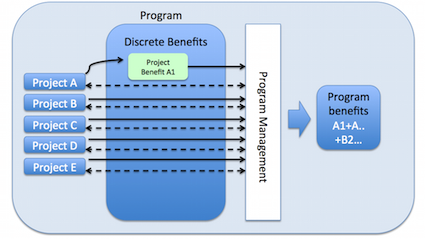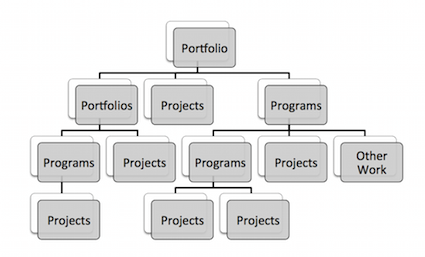Project Portfolio Management Vs. Programme Management
Both Project Portfolio Management and Programme Management are mentioned as two common extensions of today´s project management practice. It can be confusing to understand the differences. The objective of this article is to wrap up distinctions according to existing literature and best practices, by the determination of fundamental key factors and thereby clarify the differences.
Contents |
Program Management
Definition
The definition of a Program is, that a Program contains a group of related projects which are managed in a coordinated way to obtain benefits and control of the overall outcome. This approach would not be possible by managing these projects individually, without the umbrella of a program. Programs may include elements of related work (e.g., ongoing operations) outside the scope of the discrete projects in a Program. [4] When a large project is splittet into multiple related projects with explicit management of the benefits, then the effort becomes a Program. [4] In General Program Management is used for the creation of portfolios of projects [8], implementation of strategies [9] and change generation in products, business or ways of working. [10]
The distinction between a Project and a Program is given by the benefits which a Program provides over and above those that projects can archive on their own, such as exposure, prioritisation, more efficient use of resources and better alignment with other projects [10]
Key Factors
The following Key factors are determined throughout the literature and best Practice of Program Management:
- A Program contains a group of related projects
- A Program has a overall benefit which can be measured in either terms of return of investments, new capabilities and/or benefit delivery
- Programs have a Wide Scope which may change to meet benefit expectations of the organisation
- Program Managers have to expect change
- Leadership style focuses on managing relationships and conflict resolution
- Program Managers manage Project Managers
- Program Managers create high level plans providing guidance to projects where detailed plans are created
Project Portfolio Management
Definition
The term Portfolio is widely used throughout many different organisations and has come to represent different meanings. Thus the focus of this article lies on Project Portfolio Management.
The origins of Project Portfolio Management are found in the application of modern portfolio theory to the project selection problem and first mentioned in the work of Markowitz [7] The definition of a Project Portfolio is a collection of projects and/or programs and other work that are grouped together to facilitate effective management of that work to meet strategic business objectives. The Projects or Programs of the portfolio (components) may not necessarily be interdependent or directly related. [1] Project Portfolio Management is defined as a dynamic decision process, which constantly updates and revises active projects. [2] Thus Project Portfolio Management enables the organization to align the Project Portfolio to strategic objectives, thereby approving only the components that directly support business objectives, and considering the portfolio risk as a result of the mix of components in a Project Portfolio at any time. [3]
It is stated that a Project Portfolio most likely is one of the truest measures of an organisation´s intent, direction, and progress. Thereby the organisation can reasonably question components of a Project Portfolio , when they are not alligned to the strategy. [3] Hence, Project Portfolio Management as a dynamic decision making process includes the collection, identification, categorisation, evaluation, selection, balance and review of components according to the organisation´s specific key indicators and the strategic plan.
Key Factors
- A portfolio is a collection of projects and/or Programs and/or other work that are grouped together to facilitate effective management of that work to meet strategic business objectives
- The scope of a Portfolio is a business scope, that can change with the strategic goals of the organisation
- Succes is measured by the performance of Portfolio components
- The focus of the Portfolio Management lies within that programs and projects are viewed in priority for resource allocation
- The projects and/or programs may not necessarily be interdependent or directly related
- Project Portfolio Management is a dynamic decision process
- Project Portfolio Management enables the organisation to align the Project Portfolio to strategic objectives
- The portfolio risk is a result of the mix of the components
Interface
References
[1] Project Management Institute. The Standard for Portfolio Management: The Portfolio Management Framework. Project Management Institute, Inc, 2006.
[2] Cooper et al., 1998a, b; Griffin, 1997; Graves et al., 2000; Ringuest et al., 1999; Roussel et al., 1991
[3] Project Management Institute. The Standard for Program Management: The Relationship between Program Management and Portfolio Management. Project Management Institute, Inc, 2006.
[4] Project Management Institute. The Standard for Program Management: What is a Program. Project Management Institute, Inc, 2006.
[5] Project Management Institute. The Standard for Program Management: Portfolio Management Process Overview. Project Management Institute, Inc, 2006.
[6] Shao et al., 2012
[7] Markowitz, H.M. Portfolio selection 77–91 J. Financ. 7 (1), 1952.
[8] Gray, R.J., 1997. Alternative approaches to programme management 5–9. Int.J. Proj. Manag. 15
[9] Partington, D., Pellegrinelli, S., Young, M., 2005. Attributes and levels of programme management competence: an interpretive study 87–95. Int. J. Proj. Manag. 23
[10] Pellegrinelli, S., 1997. Programme management: organising project-based change 141–149. Int. J. Proj. Manag. 15
[11]

